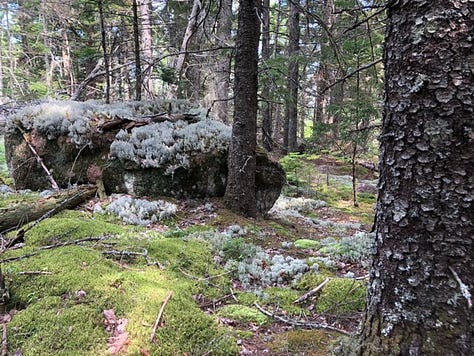Dear Spark Zen Readers, I apologize for the delay in posting the second part of my Zen Mind, Maine Mind story. It’s been a busy two weeks catching up with work since we returned from vacation. I also posted some wisdom from our hikes through Acadia National Park in the “listicle” Plan to Surrender. I hope this was worth the wait. As always, I love to hear your comments. Sending peace from San Francisco, Rev. Shōren Heather
Last time we met dear reader, I was sitting on a boulder nursing a sprained calf muscle and attempting to stave off “poor-me mind” by breathing in the sound of a melodious birdsong floating through the forest. As my spouse Tanya gently massaged my calf, it was all I could do not to cry as pain spasmed up my leg. The muscle was tight and tender and instead of feeling like one muscle, it felt pulled apart like string cheese.
Tanya’s adept & attuned fingers massaged away some of the more intense pain as I continued to place the mind’s attention on inhaling the melody and exhaling the pain. I could not stay on the boulder forever. That much I knew. Given that we were only 10 minutes away from the car, and ahead of us stretched 6.7 miles of roots, rocks, and ridges, tucking my tail between my legs and hobbling back to the safety of the cushy seats of our rented Chevy Malibu felt like the obvious decision to make. My calf muscle just wanted to rest after a short and ignominious stint on the trail.
With Tanya’s assistance I stood up, and wobbled upright onto my left leg, my non-dominant side, and for a moment, I stood like a baby heron finding her balance. Tanya helped me hop over to a pine tree. I leaned against it and rested my right foot gingerly on the earth, with the toes down and the heel up.
Like a nimble druid, Tanya quickly found a walking stick and silently offered it to me. I grasped it with a fair amount of trepidation. I was still not committed to continuing the hike. Just testing the mettle of mind and muscle. Tanya watched without comment as I shakily stood up. Which direction was I going to head? Neither of us knew.
To the surprise of both of us, I began slowly hobbling over roots and rocks toward the summit of Cadillac Mountain. After a few minutes, I sat on another boulder, cautiously extending my right leg into the air. Tanya massaged the calf muscle again and did some passive stretching. This was our routine for the first 15 minutes as we continued toward the summit, which was not visible from the two-mile path through the forested foothills. Even more of a surprise was I did not complain about the injury or the hike as I limped along.
As I write this, I realize that it was not an intellectual decision to continue toward the summit. Of course I considered how Tanya would feel if we did not continue, however, this felt more like a visceral contemplation—communing like the invisible and vast root system hidden under our feet. For many reasons, known and unknown, visceral and intellectual, I kept hobbling up the path. And, I am not a person who has any “suffer-in-silence” or “persevere-no-matter-what” genes whatsoever, so this adds to the mystery.
The pain was a minute-by-minute reminder that contained my Heather habit-mind. I mustered all the sati I could as I wended my way along the path, painstakingly placing the staff amid the brown roots and lichen-covered rocks so as not to stumble and re-injure myself. Following my breath, keeping my gaze fixed on the staff and the ground kept the monkey-mind at bay. I slowly surrendered to this hobbling gait.
None of this would have been possible had I not had the staff. A dead branch from some unknown tree was supporting me as I practiced my three-legged kinhin (“walking meditation”). Was the branch from a white or red spruce? Maybe a white cedar or an eastern hemlock? I don’t know much about tree species, and yet, I felt their kinship as we made our way under their canopy, periodically resting against their sturdy, moss-covered trunks, and feeling pine needles cushioning the soles of our barefoot shoes.
At the three temples of San Francisco Zen Center, we occasionally chant the “Self-Receiving and Employing Samadhi” or Jijuyu Zanmai during our services. This title comes from “Bendō-wā” (“On the Endeavor of the Way”), an essay written by Eihei Dōgen, the 13th century founder of Sōto Zen in Japan. The chant itself is an excerpt from the essay.
Samadhi or zanmai means “one-pointed concentration” and is a heart-body-mind experience that can arise during zazen (“seated meditation”). Actually, this description is a hairsbreadth deviation from reality because jijuyu zanmai is zazen. They are not distinct activities, as Dōgen articulates in the “Bendō-wā:”
“Sitting upright, practicing Zen, is the authentic gate to free yourself in the unconfined realm of this samādhi. Although this inconceivable dharma is abundant in each person, it is not actualized without practice, and it is not experienced without realization. When you release it, it fills your hand—how could it be limited to one or many? When you speak it, it fills your mouth—it is not bounded by length or width.”
Dōgen’s literary genius and embodied Dharma is bar none. In just two sentences he crystallizes the jewel-heart of his radical teaching of practice-realization: Buddha-nature is unconfined, inconceivable, and intrinsic in each person. Although Buddha-nature is ever-present, it’s not actualized unless we practice cultivating mindfulness in each moment.
What does jijuyu zanmai have to do with my three-legged hobble through the forest? Everything! Whether we’re sitting on a meditation cushion or a moss-covered boulder, walking mindfully or limping painfully, chanting wholeheartedly or climbing hesitatingly, there’s no escape from our relative self and Buddha-nature. The two truths of the conventional world and the absolute source are inextricably and profoundly woven together like images of dragons and elephants in a silk brocade. Neither exists without the other—so there is no “other.” There’s just this.






Because we human animals are endowed with such a magnificent, creative, and self-reflective consciousness we often forget that our ideas/projections about ourselves, others, and life in general are just that, ideas. The narratives we tell ourselves are in many ways, beside the point. I could’ve sat on the boulder for an hour whining about my hurt calf and that what happened was unfair, and blah, blah, blah.
And you know what, that “poor-me” story would not have changed the fact that my calf was injured. And the injury was not personal. The root was not out to get me. It was just being a root, and I was just being inattentive. Zazen cultivates the ability to accept conventional/conditional reality in the moment and respond from a more spacious, less karmic perspective.
Jijuyu Zanmai is one of my favorite chants because of its poetry and profundity, and its inclusion of the natural world as a manifestation of Buddha-nature. When I first began practicing Zen in 2001, I felt a deep sense of separation within myself which is the universal root of suffering. However, I also felt a deep, ineffable sense of connection with the natural world.
Although I grew up in a small city that bordered The Bronx, NY, our house was on a corner lot and surrounded by lotsa plants. The species I recall are: a Japanese magnolia tree, two beechnut copper trees, a mulberry tree, pine trees, a chestnut tree, a lilac bush, ivy, crocus, daffodils, dandelions, honeysuckle, and ferns. As an adolescent, I found much solace amid their silent presence, whether I was reclining on a sturdy branch or resting against their trunks.
I was just going to write that I felt a “connection to the plants.” However, I think it’s more accurate to say that “I did not feel separate from the plants,” and in those moments, this lack of separation was perhaps a taste of the spacious awareness that is Buddha-nature. That is our whole, True Self.
This whole True Self shining forth is what Dōgen is pointing to in one of my favorite passages from the “Self-Receiving and Employing Samadhi:”
“Because earth, grass, trees, walls, tiles, and pebbles all engage in buddha activity, those who receive the benefit of wind and water caused by them are inconceivably helped by the Buddha’s guidance, splendid and unthinkable, and awaken intimately to themselves. . . . Grass, trees, and lands which are embraced by [the Buddha’s] teaching together radiate a great light and endlessly expound the inconceivable, profound dharma. Grass, trees, and walls bring forth the teaching for all beings, common people as well as sages.”
Buddha-nature is immanent in ALL beings whether they are sentient or non-sentient, such as the dead branch that supported me as a hobbled through the forest. The branch has no name for itself. It can’t complain about my using it. It has no perception of itself as separate, or a story about how it used be part of a tree. This is how “earth, grass, trees, walls, tiles, and pebbles all engage in buddha activity.”
Daily meditation practice slowly erodes this sense of a separate me that’s created by our thinking minds. Zazen cultivates what I call “grass-tree mind.” This is one of the benefits caused by wind and water: the ever-present reminder that Buddha-nature is truly inconceivable and beyond the ability of our human consciousness to grasp it, limit it, name it, or appropriate it.
We sentient, self-reflective, me-making human mammals continuously receive the benefits caused by water, wind, fire, and earth. We awaken intimately to ourselves when we awaken intimately to our profound interconnection with all beings.
As we emerged from the forested palace of the peaceful pines, with the help of my sturdy staff and my steadfast spouse, I ascended the summit with all beings.




